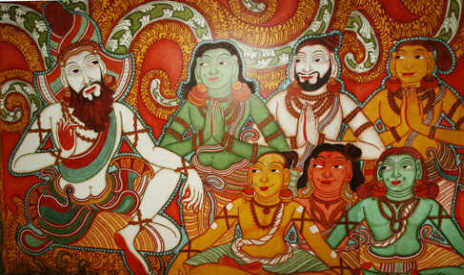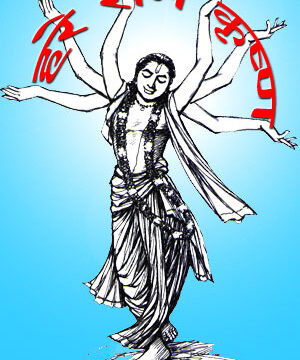Ṛṣi Atri (family) » Rathātreya Ṛk Veda Maṇḍala 5; Pt. Sanjay Rath belongs to Atri Gotra i.e. the lineage of Brahmarṣi Atri and Anasuyā Devi.
Ṛṣi Atri (family) » Rathātreya RV
Pt. Sanjay Rath belongs to Atri Gotra i.e. the lineage of Brahmarṣi Atri and Anasuyā Devi. Brahmarṣi Atri is the seer of the fifth maṇḍala (book) of the Rig Veda. He had many sons including the three famous ones – Soma, Datta and Durvāsā who were the incarnations of the trimūrti – Brahma, Vishnu and Rudra respectively. The trimūrti channeled through Brahmarṣi Atri when they granted boons to his wife Devi Anasuyā for helping the Sun to rise in the east everyday. Datta is called Dattātreya i.e. Datta the son of Atri as Vishnu always respects the lineage. Similarly Soma is called Chandratreya and Durvasa is Krishnatreya. Somātreya (Chandra) established the Someśvara Jyotirliñga used to overcome all kinds of passion. Soma has the power to cause any species to continue i.e. the power of creation as he is the incarnation of Brahma.
Boons are granted after testing both parents. Just as Atri had surpassed every form of penance known including standing on one leg for a thousand years and reciting the Dakṣiṇāmūrti mantra, Devi Anasuyā was also tested by the Trimūrti. The Trimūrti tested the chastity of Anasuyā. They arrived as Brahmins and requested for food on the condition that she has to serve it in the nude. Anasuyā agreed without any hesitation and used her śaktī to convert the brahmins (actually Trimūrti) into babies and offered them food without any dress. The trimūrti reverted back to their original form only after they were fed and Anasuyā had dressed – and blessed her.
Brahma Purāṇa adds that the blessings of Durgā resulted in the birth of a daughter Śubhatreyī. Other sons were involved in various activities. Ratha, the son of Atri, was involved in receiving and recording some parts of the fifth maṇḍala of the Rig Veda. Hence he embodied the Veda and is referred to as Rathātreya i.e. Rath, the son of Atri. There are a number of famous names belonging to the lineage of Atri – Śāvāśva, Avishtir, Purvātithi, Mudgala, Uḍḍālaki, Śākalāyani, Chāndogya, to name a few. The greatest contribution of the Atreyas is the Rig Veda. There are two main brāhmaṇas (books) that are used to understand and learn the Veda of which the Atri Brāhmaṇa is considered the purest and highest.
Ṛṣi Atri finds mention in almost every list of the Ṛṣi’s drawn up for various purposes.
- The most important list for Brahmin’s is the three who discovered AUM the cosmic sound symbolising creation or Brahma (a), preservation or Vishnu (U) and dissolution or Shiva (M). These three were Ṛṣi Gautama (A), Ṛṣi Atri (U) and Ṛṣi Bharadvaja (M). He followed his father Brahma in giving the sacred thread which has three strands symbolizing A-U-M. Together these three strands indicate the vow that a Brahmin takes to recite and adhere to AUM (also pronounced OM). The first three threads of the Brahma vrata (promise of the Brahmin) is related to Bhū loka (earth plane). The second set of three threads is given after marriage and is related to the Bhuva loka (solar system) while the third set of three threads Dīkṣa (initiation)and is related to svarga loka (heavens).
- Then there is the list(s) of Saptarṣi or the seven seers associated with the pole star [Big Dipper] where Ṛṣi Atri always features with Ṛṣi’s Kaśyapa and Vasiṣṭha. These are the seven Mind born (Manasa Putra) of Brahma and the progenitors of the human race.
- He is a Brahmarṣi as well indicating complete understanding of the Brahman or supreme truth.
- He is a MahaṚṣi and the original teacher of Ayurveda, Jyotiṣa, Astronomy, Gaṇita (Mathematics), Poetry and Prose etc.

Traditional Kerala mural painting of Ṛṣi Atri patriarch of Ayurveda with his six disciples by K.R. Babu, +91-495-27640 krbabu2002@rediffmail.com
Atri Ṛṣi is one of the ten Mānas sons of Brahmā: Angira, Atri, Bhṛgu, Dakṣa, Kratu, Marīci, Nārada, Pulaha, Pulastya, Vasiṣṭha.
Devi Anasuyā one of the nine daughters of Kardama Ṛṣi and Devahūti was his wife.
Devahūti was one of the three daughters of Manu (Devhūti, Prasūti, and Ākṛti). The marriage of Kardama Ṛṣi with Devahūti produced nine daughters and one son – Ṛṣi Kapila. The lineage from the nine daughters is as follows: –
1. Kalā – married Ṛṣi Marīci
2. Anasuyā – married to Ṛṣi Atri and they had three sons Durvāsa (Shiva’s blessings), Dattātreya (Vishnu’s blessing) and Moon or Soma (Brahmā’s blessing)
3. Gati – married Ṛṣi Pulaha
4. Kriyā – married Ṛṣi Kratu
5. Khyāti – married Maharshi Bhṛgu
6. Arundhatī – married MahaṚṣi Vasiṣṭha and Ṛṣi Śaktī the father of Parāśara and grandfather of Krishna Dvaipāyana (Veda Vyāsa) was born.
7. Shānti – married to Atharvan ṛṣi whose daughter was married to Vedavyāsa Krishna Dvaipaayana.
8. Havirbhū – married Ṛṣi Pulastya and they had two sons: Ṛṣi Agastya and Ṛṣi Viśravā
9. Śraddhā – married Maharṣi Aṅgirās and they had sons of whom the most illustrious was Bṛhaspati.
Sapta-Ṛṣis given in major Hindu texts
1. The Satapatha Brahmana of Sukla Yajurveda says they are: Gautama, Bharadwaja, Viswamitra, Jamadagni, Vasishtha, Kasyapa, and Atri.
2. Krishna Yajurveda in the Sandhya-Vandana Mantras has it as: Atri, Bhrigu, Kutsa, Vasishtha, Gautama, Kasyapa, and Angirasa.
3. Mahabharata gives the Seven Ṛṣis’ names: Kutsa, Vasishtha, Atri, Agastya, etc.
4. V. S. Apte’s Sanskrit-English dictionary says: Marichi, Atri, Angirasa, Pulaha, Kratu, Pulastya, and Vasishtha.
5. The Brihadaranyaka Upanishad (2.2.4) enumerates them as: Gotama, Bharadwaja, Viswamitra, Jamadagni, Vasishtha, Kasyapa, and Atri.
Brahmarshi Atri is the seer of the Fifth Mandala of the Rig Veda. There are 10 mandala or books in the Rig Veda comprising 1028 hymns (or 1017 excluding the 11 valakhiya hymns 8.49 – 8.59) of which Mandala 2 to 7 belong to particular Ṛṣi lineages and were composed by the seer assisted by his children and disciples. These are the oldest as well. Ratha, the son of Atri was one such able son and composer of Mandala Five to which lineage we, the ‘Rath’ Atri’s belong – called Rathātreya.
There are two major branches of study of the Rig Veda – Śākala (Aitareya Brāhmaṇa, also known as Ashvalayana Brāhmaṇa) and Bāśkala (Kaushitaki Brāhmaṇa with the Khilani which is a latter day 98 hymn addition).
Ṛṣi Atri lived with Devi Anasuyā at Chitrakoot, near south Uttar Pradesh (about 25N Lat) where they met Lord Rama and Sita when the latter were banished for 14 years. There are many people having the title ‘Rath’ in Uttar Pradesh in India. We do not know when a branch of the Rathātreya’s went to Dwarka in Saurashtra. About seven hundred years back the family travelled from Somanāth in Dwarka to Kanyakubja (Mithila, North Bihar) and then accepting the invitation of the King of Jagannath Puri, they arrived in Orissa a few centuries back (see history of Orissa for details) and were established in Bira Balabhadra Pur Sasana.
The direct family lineage
- Pt. Somanath Rath
- Pt. Ramakrusna Rath
- Pt. Jagannath Rath
- Pt. Kashinath Rath (third son of Pt.Jagannath Rath)
- Pt. Sanjay Rath (nephew of Pt.Kashinath Rath & son of Umakant Rath)

Pandit Sanjay Rath’s childhood was spent in joy with parents and a big family, attending to various family functions and learning from the traditions. His schooling was at Stewart School, Bhubaneswar (till matriculation). Thereafter he left for Bangalore for two years (1980-82) to study at Bishop Cottons Boys School and later did his graduation in Mechanical Engineering from Anna University, Madras. He left Government service in 2000 to continue in the lineage of his forefathers.
They trace their Jyotiṣa from Sri Acyutānanda Das, one of the Pañca sakhā (five great disciples) of Sri Chaitanya Mahaprabhu who was considered the reincarnation of Sri Garuḍa, the golden eagle of Jagannāth Viṣṇu to save the light (agni) from extinguishing in the Kali Yuga which is really Jyotiṣa. Some of the astounding predictions of Mahāpuruṣa Acyutānanda continue to come true to this date showing the depth of his understanding and his proof that Jyotiṣa is really vedāñga and a very spiritual subject.
Further reading
- Divinizing Life: The Path of Atri Ṛṣi by R.L. Kashyap; Hardcover, Dec 2004
- Torch Bearers of Vedic Traditions : Brahmin Sasan Villages in Orissa by Nityananda Patnaik. New Delhi, Classical, 2002, ix, 227 p., tables, maps, sketches, ISBN 81-7054-346-0.
- Rig Veda Maṇḍala V translation by Dayanand Saraswati
- Aitereya Brāhmaṇa



















 DBC offers online courses in jyotish (Vedic Astrology) taught directly by Sanjay Rath as per the tradition, through narrated power points and other audio tools. The courses are at different levels, from the beginners through the intermediate to the advanced and are known as SoHamsa | DBC courses, with individual classrooms and assistant teachers
DBC offers online courses in jyotish (Vedic Astrology) taught directly by Sanjay Rath as per the tradition, through narrated power points and other audio tools. The courses are at different levels, from the beginners through the intermediate to the advanced and are known as SoHamsa | DBC courses, with individual classrooms and assistant teachers
 Sagittarius Publications is the publisher and distributor the popular quaterly magazine the Jyotish Digest, as well as many thorough books on the subject of Vedic Astrology or Jyotish.
Sagittarius Publications is the publisher and distributor the popular quaterly magazine the Jyotish Digest, as well as many thorough books on the subject of Vedic Astrology or Jyotish. We have an excellent pandit Divākar ‘Deva’ Mishra, who is from the priests of Vindhyāvāsini Siddha Pīṭha to guide you through the hundreds of temples of Kāśi [Varanasi] and neighbouring regions. He can organise your pūjā, keep you safe and take care. He is supported by an English-speaking well-travelled spouse ‘Supriya Mishra’. Please contact them directly for any services, remedial pūjā and tours. They handled the 60+ member Kāśi Jyotiṣa Group 2022.
We have an excellent pandit Divākar ‘Deva’ Mishra, who is from the priests of Vindhyāvāsini Siddha Pīṭha to guide you through the hundreds of temples of Kāśi [Varanasi] and neighbouring regions. He can organise your pūjā, keep you safe and take care. He is supported by an English-speaking well-travelled spouse ‘Supriya Mishra’. Please contact them directly for any services, remedial pūjā and tours. They handled the 60+ member Kāśi Jyotiṣa Group 2022.
Pt. Pls post other inform in this side